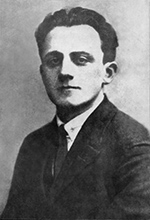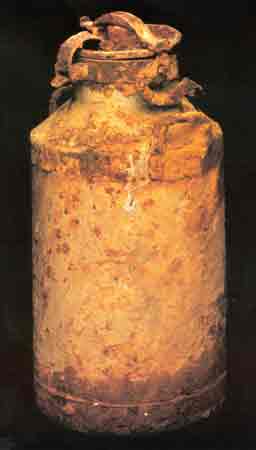Emanuel Ringelblum
(1900–1944)

Emanuel Ringelblum was a historian of the Warsaw ghetto. Born in Buczacz, eastern Galicia, Ringelblum graduated from Warsaw University and subsequently taught history at a high school. He published a number of articles, mainly on the history of Warsaw Jewry, in which (influenced by the historian Ignacy Schiper) he stressed social and economic problems. He was a member of YIVO and, in 1928, a founder of the “Circle of Young Historians” in Warsaw, which published the periodical Der Yunger Historiker.
Throughout his life, Ringelblum combined public activity with his academic work. He was active in the left-wing Po’alei Zion and participated in the work of the Yiddish schools’ association (Tsentrale Yidishe Shul-Organizatsye). From 1929, he was the editor of Folkshilf, the publication of the Jewish cooperative funds.
In 1938, the American Jewish Joint Distribution Committee sent him to the frontier townlet of Zbaszyn, where 17,000 Jews who were Polish nationals living in Germany had been gathered and left destitute after being suddenly deported over the Polish border from their places of residence. They were caught in no man’s land, unable to enter Poland. Ringelblum directed relief work, collected testimonies from the deportees, and gathered information on events in Nazi Germany.
During the siege and air attacks on Warsaw, Ringelblum was a regular participant in the activities of the coordinating committee of Jewish-aid organizations. Later, when the Juedische Soziale Selbsthilfe (JSS) for self-help was formed out of this committee, Ringelblum headed the department to rally the Jewish population to mutual assistance, including help to the needy and shelter to the deportees and those whose homes had been destroyed. In the course of this work, Ringelblum kept in constant contact with active sources of information in the community at large, from whom he received reports and evidence on events in the capital and provincial towns at a time when there was no press other than the Nazi-approved and controlled press.
Ringelblum understood that what was happening to Polish Jewry was without precedent and correctly perceived his efforts as providing the basic raw material for future histories of the ghetto and of Polish Jewry during the war. The work that Ringelblum directed is widely regarded as an essential manifestation of spiritual defiance, working against all Nazi efforts to eradicate memory and correctly believing against hope and against all odds that Jews somewhere, if not in Poland, would be able to write their own history of the killings and not rely on German documentation alone.
 |
He recorded this information himself and directed his assistants, whose numbers steadily grew. Thus, a large and diversified enterprise was established for the collection of documents, reports, evidence, summaries, and even research work, memoirs, and literature produced during the period. The secretary of the underground archive reported that “every item, every article, be it long or short, had to pass through Dr. Ringelblum’s hands.” The enterprise was given the code name Oneg Shabbat (literally “Enjoyment of the Sabbath”) and employed dozens of workers directed and encouraged by Ringelblum. The operation used the Jewish Social Self-Help (ZSS), an organization tolerated by the Nazis, as a cover for its activities. The office of this social service is now the storage sight of the archives.
He also made efforts to have this material transmitted to London and through London to the West. According to HISTORY, his efforts led to the first public account of the Holocaust, published on June 1, 1942, in the underground Polish Socialist newspaper Liberty Brigade. According to HISTORY, Ringelblum reported the gassing of tens of thousands of Jews at Chelmno and the deportations of Warsaw Jewry after having escaped from the camp. He was never there, however, but he did report information he received from a man who did escape from Chelmno.
After the massive deportation of the summer of 1942, Ringelblum became a believer in armed resistance. After the great deportations, he worked with renewed urgency; no longer dealing in details, he sought to grapple with the larger issues of ghetto life in an attempt to comprehend what was happening. He created biographical notes on some of the great figures in the ghetto. Before the ghetto was destroyed, collections of material were put in containers and buried in three – or perhaps more – caches. Parts were buried in the cellars of Warsaw buildings.
Ringelblum left the ghetto with his wife and young son and returned to the ghetto alone during the uprising. What precisely happened to him is not known, but he was arrested and found in the Trawniki camp. Two people arranged for his escape, and he was brought to Warsaw, where he was hidden with other Jews.
He worked to the very end. This work even continued in the “Aryan” district after the destruction of the ghetto. In hiding, he composed his masterwork on Polish–Jewish relations during World War II. Almost exactly a year after the uprising, he was betrayed by 18-year-old Jan Lakinski, and the Gestapo discovered his hiding place at 81 Grójecka Street in the “Aryan” district on March 7, 1944. He and his family were arrested and, along with those who hid them, executed in Pawiak Prison. After the war, Lakinski was tried by a Polish court and sentenced to death.
Only two caches were recovered from the ruins after the war, the third was never found. Among approximately 25,000 sheets that were preserved are detailed descriptions of the destruction of ghettos in other parts of occupied Poland, the Treblinka extermination camp, the Chelmno extermination camp, and a number of reports made by scientists conducting research on the effects of famine in the ghettos. Also noteworthy is the collection of clandestine newspapers in various languages.
The material discovered became the property of the Jewish Historical Institute in Warsaw (there are photocopies in Yad Vashem, Jerusalem, and the United States Holocaust Memorial Museum). In the 1990s, extensive efforts were made to preserve this documentation and to translate and publish this invaluable material. The Oneg Shabbat material is the main source for research into the history of Polish Jewry under German occupation.
Ringelblum’s own notes, summaries, and essays, written during the occupation, were published after the war in Ksovim fun Geto (2 vols., 1961–63; Notes from the Warsaw Ghetto, ed. and tr. by J. Sloan, 1958). He also wrote Kapitlen Geshikhte fun Amolikn Yidishn Lebn in Poyln (1953) and Di Poylishe Yidn in Oyfshtand fun Kościuszko 1794 (1937). Notes on the Refugees in Zbiszyn chronicled the deportation of Jews from the town of Zboszy,
BIBLIOGRAPHY
Kermish, in: Yad Vashem Studies, 7 (1968), 173–83; idem, in: Yad Vashem Bulletin, 16 (1965), 16–25; Kozhen, ibid., no. 6–7 (1960), 21–23; Eisenbach, in: E. Ringelblum, Ksovim fun Geto, 1 (1961), 13–60 (introd.); Eck, in: Goldene Keyt, 6, no. 24 (1955), 107–21. ADD. BIBLIOGRAPHY: E. Ringelblum, Writings from the Warsaw Ghetto, ed. J. Kermish and Y.L. Peretz (Yid., 1985); idem, Polish-Jewish Relations during the Second World War, ed. J. Kermish and S. Krakowski (1976); J. Kermish (ed.), To Live with Honor and Die with Honor! Selected Documents from the Warsaw Ghetto Underground Archives (1986).
Sources: Encyclopaedia Judaica. © 2007 The Gale Group. All Rights Reserved.
“Emanuel Ringelblum,” JewishGen.
“Emanuel Ringelblum,” Wikipedia.
Szlama Ber Winer,
Wikipedia.
Emanuel Ringelblum,
Holocaust Historical Society.
Anna Majchrowska, This is probably the last letter I’m writing to you...,
Jewish Historical Institute.
“700,000 Jews killed in Poland,” BBC, (June 2, 1942).
News of Holocaust death camp killings becomes public for first time,
History, (May 28, 2020).
Photos: portrait - uploader Koperczak (talk) 13:34, 16 March 2009 (UTC), Public domain via Wikimedia Commons.
Can - http://www.ushmm.gov, Public domain via Wikimedia Commons.


